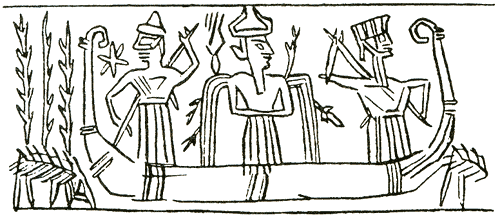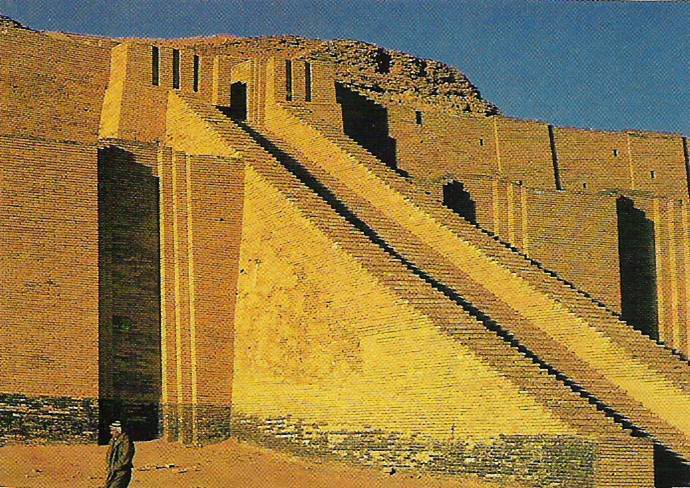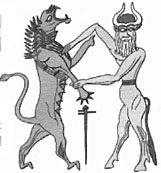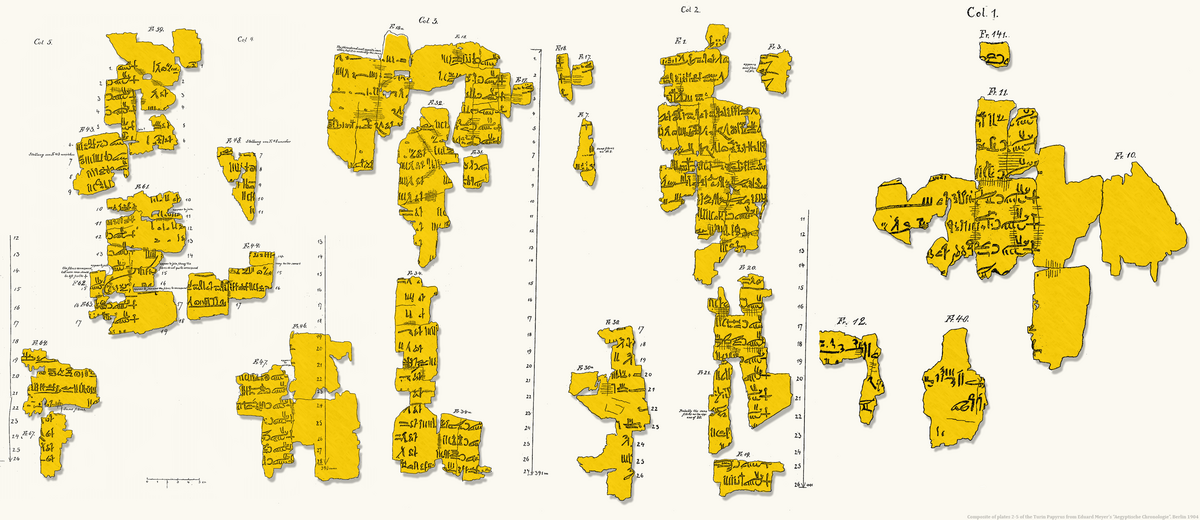The Anunnaki
The Sumerian text speak of their Great gods called the Anunnaki, which can have several meaning, but the Anu were the heavenly ones and Ki translates as earth, so the word Anunnaki could literally translate, "Those from heaven that were sent to earth"
Compared to the Sumerians the Anunnaki were very well dressed and groomed. Their breads were long and braided and their dress was formal and heavily embroidered.
In the image below an Anunnaki is seen wearing his formal dress and having well groomed long hair and a braided beard. This was not only how they dressed, but it was signifying their position and who they were.
The early Kings of Mankind's history copied this dress, and braided beards, to indicate their status as royal. The female Pharaoh's of Egypt would even wore false braided beards to indicate kingship.
The image above is the King of Assyria and the King of Babylon seen while they are shaking hands.What is of note is their dress and braided breads. Their attire is solely for their royal status, copied from the Anunnaki whom they saw as the pinnacles of status.
The Sumerian text records the Anunnaki as coming from heaven to Earth, but they were definitely human. They were not spirit forms. They had the ability of long everlasting life, but they were not immortal and could die, either by accident or by combat. They seemed to enjoy the contact with mankind and enjoyed the pleasures of the women of Sumeria.
The relationship with the Sumerians took a symbiotic relationship, with the Sumerians acquiring scientific, agriculture, husbandry and mathematical knowledge from the Anummaki, while the Anunnaki received labour to irrigate and grow crops, produce beer and most importantly mine significant amounts of ore.
The Anunnaki were administrated by a council, and the council had leaders. Enki was one such great leader and his name means, En translates as lord and Ki translates as Earth. so therefore Enki was the "Lord of the Earth". All important issues were discussed at these council meetings and agreed upon. Any criminal or civil action could also fall under the authority of the council. As a case in point of a rape charge against a high ranking Anunnaki. The girl was brought before the council and questioned, then cross examined. Similar to a modern court drama. The result was the Plaintiff was found guilty.
The first thing the Anunnaki did upon arriving on Earth was to construct a city. Enki builds what is considered the first city built on Earth named Eridu, at the southern end of the Mesopotamia valley, and in this city a temple is built. The text reads;
"Next to Anu he seated Enlil, Nintu he seated at the big side, The Anunnaki seated themselves one after the other. Enlil says to the Anunnaki: " Ye great gods who are standing about, My brother has built a house, the king Enki; Eridu, like a mountain, he has raised up from the earth, In a good place he has built it. Eridu, the clean place, where none may enter, The house built of silver, adorned with lapis laz uli,"

The mound of the ancient city of Eridu, located in southern Iraq. There is also topographical evidence that the city once had lakes surrounding it.
One of the pleasures Enki has while living in his city, was to go for a boat ride on the lakes near Eridu,, really not much different than people today enjoying the water. Below is an ancient illustration of Enki in his boat;

Next was the construction of the temple, which was elaborate and extensive. The question is; what was it's purpose?Modern archaeologists believe that being a temple, they must have served as a religious importance, but is this true? Others suggest ancient temples were aligned with the stars or constellations. And still others believe that they were aligned with the spring equinox or the summer solstice.
What was special about these temples that were constructed in ancient Sumerian cities, was they were not constructed for the Sumerians. Either for their use as in worship or as a centre for their culture. The temples were built for the absolute sole use of the Anunnaki. This point is very clear.
The temples were called Ziggurats, The Ziggurats were constructed of 7 levels rising above the city with their corners, not their sides pointing to the four compass direction points. There was no astrological connection to their positioning, or an alignment to the spring equinox or summer solstice. The Anunnaki were highly intelligent and didn't require a building site to determine the approaching of spring or when summer was near. So the question still remains what were these temples built for? Below the Ziggurat at the ancient site of Ur, which had been rebuilt many times over the Centuries.

Just as Ancient Mankind copied the dress and appearance of the Anunnaki they also copied their temples. The Egyptians long before they built pyramids they built exact replicas of Sumerian Ziggurats. They were called Mastabas and like the Ziggurats they were built from clay bricks.

The Mastabas (above) had the same tier leveling architecture, in following with the Ziggurats of Mesopotamia. The Egyptians understood the style of construction but as with the Sumerians they never understood their purpose. The Egyptians determined them to be burial sites for their Kings. The Anunnaki though had no concern for a burial site since they had the opportunity for everlasting life. The ancient cuneiform text reads;
they kept immortality for themselves.
The unified ruler of ancient Egyptian under King Djoser in the aerial photo above, shows his pyramid with it's 7 steps at Saqqara. Pyramid temples were built near the centre of a complex indicating their importance.
These temples were extremely important to the Anunnaki as many of their reliefs show them atop their Ziggurats. At the top to the Ziggurats was the temple centre piece, and this substantiated the existence of the Temple itself. This singular important location was what the Anunnaki called the ABZU. The meaning of Abzu is distant or deep water. Ab translates as water and Zu as distant/ deep.
The Abzu is something more than just distant water, as this text suggest; "Abzu the pure place where the fates are determined".
The Abzu was central to their very lives for without it, the Anunnaki would loose their longevity to their existence.
{The Sumerian Abzu Blog}
In the Sumerian tale of the Turtle and Ninurta, Enki sets an ambush at the gate of the Abzu, and traps Ninurta.
Against Ninurta, Enki fashioned a turtle from the clay of the abzu. Against him he stationed the turtle at an opening, at the gate of the abzu.
This gate is at the top of the temple Ziggurat.

The above image shows an Anunnaki that has climbed atop the Ziggurat, (illustrated by the cone shaped objects, as if indicating the 7 tiers of the Ziggurat itself), and making entreaty to Enki seen siting at the gate of the Abzu, surrounded by water. (also illustrated as the door atop the coned Ziggurat just above the Anunnaki)
These pyramid shaped temples were built wherever the Anunnaki resided on earth. In Egypt and in South and Central America some these magnificent structures still remain. Centuries later long after the disappearance of the Anunnaki, mankind chose to use them for their own purposes. These temples then became central to the religious beliefs of man. These temples then changed from their original purpose to become part of an after life and a venerated burial site for mankind. To this day archaeologists believe that the Great Pyramid was built by the Old Kingdom of Egypt. A civilization that up to that point in history showed little ability to build such an empowering structure.


Many of the reliefs of the Great Gods show them having a 1/2 man half fish like appearance. In the relief above is a very common depictions showing the Anunnaki on either side of the tree of life and looking up and pointing to a chariot of the Gods. Their appearance is fish like.
The early Kings of Mankind's history copied this dress, and braided beards, to indicate their status as royal. The female Pharaoh's of Egypt would even wore false braided beards to indicate kingship.
The image above is the King of Assyria and the King of Babylon seen while they are shaking hands.What is of note is their dress and braided breads. Their attire is solely for their royal status, copied from the Anunnaki whom they saw as the pinnacles of status.
The Sumerian text records the Anunnaki as coming from heaven to Earth, but they were definitely human. They were not spirit forms. They had the ability of long everlasting life, but they were not immortal and could die, either by accident or by combat. They seemed to enjoy the contact with mankind and enjoyed the pleasures of the women of Sumeria.
The relationship with the Sumerians took a symbiotic relationship, with the Sumerians acquiring scientific, agriculture, husbandry and mathematical knowledge from the Anummaki, while the Anunnaki received labour to irrigate and grow crops, produce beer and most importantly mine significant amounts of ore.
The Anunnaki were administrated by a council, and the council had leaders. Enki was one such great leader and his name means, En translates as lord and Ki translates as Earth. so therefore Enki was the "Lord of the Earth". All important issues were discussed at these council meetings and agreed upon. Any criminal or civil action could also fall under the authority of the council. As a case in point of a rape charge against a high ranking Anunnaki. The girl was brought before the council and questioned, then cross examined. Similar to a modern court drama. The result was the Plaintiff was found guilty.
The first thing the Anunnaki did upon arriving on Earth was to construct a city. Enki builds what is considered the first city built on Earth named Eridu, at the southern end of the Mesopotamia valley, and in this city a temple is built. The text reads;
"Next to Anu he seated Enlil, Nintu he seated at the big side, The Anunnaki seated themselves one after the other. Enlil says to the Anunnaki: " Ye great gods who are standing about, My brother has built a house, the king Enki; Eridu, like a mountain, he has raised up from the earth, In a good place he has built it. Eridu, the clean place, where none may enter, The house built of silver, adorned with lapis laz uli,"
The mound of the ancient city of Eridu, located in southern Iraq. There is also topographical evidence that the city once had lakes surrounding it.
One of the pleasures Enki has while living in his city, was to go for a boat ride on the lakes near Eridu,, really not much different than people today enjoying the water. Below is an ancient illustration of Enki in his boat;

Next was the construction of the temple, which was elaborate and extensive. The question is; what was it's purpose?Modern archaeologists believe that being a temple, they must have served as a religious importance, but is this true? Others suggest ancient temples were aligned with the stars or constellations. And still others believe that they were aligned with the spring equinox or the summer solstice.
What was special about these temples that were constructed in ancient Sumerian cities, was they were not constructed for the Sumerians. Either for their use as in worship or as a centre for their culture. The temples were built for the absolute sole use of the Anunnaki. This point is very clear.
The temples were called Ziggurats, The Ziggurats were constructed of 7 levels rising above the city with their corners, not their sides pointing to the four compass direction points. There was no astrological connection to their positioning, or an alignment to the spring equinox or summer solstice. The Anunnaki were highly intelligent and didn't require a building site to determine the approaching of spring or when summer was near. So the question still remains what were these temples built for? Below the Ziggurat at the ancient site of Ur, which had been rebuilt many times over the Centuries.
Just as Ancient Mankind copied the dress and appearance of the Anunnaki they also copied their temples. The Egyptians long before they built pyramids they built exact replicas of Sumerian Ziggurats. They were called Mastabas and like the Ziggurats they were built from clay bricks.

The Mastabas (above) had the same tier leveling architecture, in following with the Ziggurats of Mesopotamia. The Egyptians understood the style of construction but as with the Sumerians they never understood their purpose. The Egyptians determined them to be burial sites for their Kings. The Anunnaki though had no concern for a burial site since they had the opportunity for everlasting life. The ancient cuneiform text reads;
What you seek you shall never find.
For when the Gods made man they kept immortality for themselves.
The unified ruler of ancient Egyptian under King Djoser in the aerial photo above, shows his pyramid with it's 7 steps at Saqqara. Pyramid temples were built near the centre of a complex indicating their importance.
These temples were extremely important to the Anunnaki as many of their reliefs show them atop their Ziggurats. At the top to the Ziggurats was the temple centre piece, and this substantiated the existence of the Temple itself. This singular important location was what the Anunnaki called the ABZU. The meaning of Abzu is distant or deep water. Ab translates as water and Zu as distant/ deep.
The Abzu is something more than just distant water, as this text suggest; "Abzu the pure place where the fates are determined".
The Abzu was central to their very lives for without it, the Anunnaki would loose their longevity to their existence.
{The Sumerian Abzu Blog}
In the Sumerian tale of the Turtle and Ninurta, Enki sets an ambush at the gate of the Abzu, and traps Ninurta.
Against Ninurta, Enki fashioned a turtle from the clay of the abzu. Against him he stationed the turtle at an opening, at the gate of the abzu.
This gate is at the top of the temple Ziggurat.
The above image shows an Anunnaki that has climbed atop the Ziggurat, (illustrated by the cone shaped objects, as if indicating the 7 tiers of the Ziggurat itself), and making entreaty to Enki seen siting at the gate of the Abzu, surrounded by water. (also illustrated as the door atop the coned Ziggurat just above the Anunnaki)
These pyramid shaped temples were built wherever the Anunnaki resided on earth. In Egypt and in South and Central America some these magnificent structures still remain. Centuries later long after the disappearance of the Anunnaki, mankind chose to use them for their own purposes. These temples then became central to the religious beliefs of man. These temples then changed from their original purpose to become part of an after life and a venerated burial site for mankind. To this day archaeologists believe that the Great Pyramid was built by the Old Kingdom of Egypt. A civilization that up to that point in history showed little ability to build such an empowering structure.
In 1822, the Italian Egyptologist Bernardino Drovetti discovered a mysterious papyrus document near the Thebe’s necropolis. It dates back to the Dynasty, during Ramesses II reign.
This document was called the Turin Royal Canon and speaks about Zep tepi or the First time of Osiris.
The main characteristic of this document is a long list of Kings of Egypt that ruled Egypt pre diluvian, before the thirty dynasties that scholars today officially approve. This gives rise to a much longer period of a sophisticated society living in Egypt, when the Great Pyramid was originally built. The sequence of the King's listed, originated some 33,000 years before the dynasty age.
What gives credence to this document is that the Sumerian King List also lists ruling Kings in the Valley of Sumer, that ruled in this pre flood era. Two unrelated documents that both record the same history, make the history authentic. Scholars still do not accept this as history, but see this period as simple myths.
John Anthony West proposed his reasoning, absolutely worthy, when he wrote:
As if today's Egyptologists know more about ancient Egyptian history than the ancient Egyptians themselves. That is the standard height of academic arrogance
(West’s research was dating the Sphinx extensive water erosion that can be seen from atop the Sphinx)
Who did build the Great pyramid? Most scholars believe that Khufu was responsible for the earth’s greatest construction feat, pointing to his cartouche in the Campbell's chamber as giving evidence.
Fig. 1 above is the existing cartouche in the Great Pyramid
Fig. 2. Below is the cartouche recorded in Vyse’s journal.
In May 27th 1837 Col. Vyse recorded in his journal a cartouche he discovered in the Great Pyramid. What is bizarre about his cartouche is that it does not spell Khufu’s name correctly, Vyse’s cartouche has since been modified in a restoration to correctly spell Khufu’s name as indicated in Fig. 1 to support the belief of the builder of the Great Pyramid. This oddity is not the most unusual detail about a King recording his name on such a magnificent structure.
The Great Pyramid has no painting, no art work, no painted drawings, no inscribed depictions and no stone cutting depicting a language or figure.
If you were a great King of Egypt; would you send someone to misspell your name in paint which fades through time, in one of the most difficult and obscure locations in the pyramid, when the whole of the pyramid is entirely bare?
Who painted this misspelled cartouche? None other than Vyse himself. He painted the cartouche of Khufu to gain for himself fame, fortune and note aridity, thus being the first to identify the builder of the Great Pyramid. If he drew the cartouche in a well known visible location in the pyramid it would have been quickly seen as a fake, but hiding the cartouche in a very difficult location would allow his fiendish plan to be accepted.
Since then, scholars have been misled to believe that Khufu was the builder of one of the seven wonders of the world. The normal evidence of the steps required to achieve such an imaginative process are lacking, and neither the physical construction nor the social philosophy behind it have no historical precedent in Egypt.
Mankind may have started over several times throughout the millenniums of time that man has existed on earth. The great period of time before the diluvian epoch, gave rise to some advanced learning, which enabled the Egyptians to build great structures. The Great Pyramid and the Sphinx were both built during this time when the Gods ruled Egypt and walked among mankind.
Many of the reliefs of the Great Gods show them having a 1/2 man half fish like appearance. In the relief above is a very common depictions showing the Anunnaki on either side of the tree of life and looking up and pointing to a chariot of the Gods. Their appearance is fish like.

Dagan picture below is seen as a fish god.
In one of the earliest known artifacts of a sculptured Anunnaki, dating around 5000 BC , the Anunnaki is wearing the horned headdress and long bread, indicating his status, but also what appears is that his skin, has a fish scale like appearance.
Were the Anunnaki able to extend their lives as the relief seems to indicate with the help of their chariot of the Gods?
{The Babylonian History of Mankind Included a Great Creature Named Oannes blog}
Not just extend their lives, but change their form.
By about 2000 BC the Anunnaki start to disappear throughout the earth. For what reason no one is sure. One suggestion is that they are losing their influence and power over mankind as man's earthly knowledge was superseding their need for the Anunnaki. They were no longer seen as Great Gods. One thing is sure is that one Anunnaki stayed on earth to influence man. That God was Dagan, the God of the Semitic people.
{ Dagan the First God of the Semitic People blog}
Dagan was marooned on the earth, by Enki's order. After the destruction of the Akkadian nation and it's great city Agade and just prior to the fall of Agade it's capital, Enki orders all of it's treasury, of this great city, to be brought to his Abzu. Enki doesn't stop there but atop the Ziggurat at Agade the poles of the Abzu are to removed by his order, indicating that the function of the Abzu for Dagan is finished.
The text reads; “Ninurto brought the jewels of ruler ship, the royal crown, the emblem and the royal throne bestowed on Agade.”
"Enki tore out its well-anchored holy mooring pole from the abzu. Inana took away its weapons."
Dagan at this point is alone, and without connection to the Abzu controlled by Enki, he is now isolated and marooned on earth. The text indicates that all the Anunnaki had turned against Dagan to destroy his Semitic seed, the Akkadians.
Dagan then becomes the driven god of the Semitic people. To make them rulers of the Earth. His ego and lust for power seeks no end.
The Bible texts indicate what he has become; The God of the Semitic Akkadians had become a God of never ending “bragging”. Isaiah 45; versus 11-21 is just one of the many examples, Job chapter 38 another. “I made the earth and I created man- I created the heavens”. There is pages upon pages of this never ending self posturing, incessant bragging. My point from all of this is; if there is a 'One God the creator”, that sees fit to come down from his heavenly place, and speak to a lowly human on earth, which can be no more than a fly speck in relation to the Universe, then why does he have to spend an inordinate amount of time bragging to this fly speck? Does he have some personal insecurity issues, or is this an attempt by Dagan/ Yehwah to support his need and human reliance and therefore vindicate his own agenda. I just cannot imagine an omnipotent God the Creator, to feel the satisfaction of man's approval, and the need to be worshiped. It sounds preposterous.
Is there some indication that Dagan is still alive, influencing the world, or without the Abzu has he died as with all mankind?





